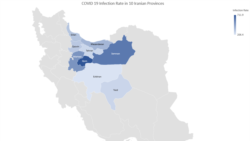By gathering data from dispersed official comments by provincial authorities and local news agencies Radio Farda has been able to confirm that at least 1,300 have so far died of coronavirus (COVID-19) in Iran and at least 32,000 have been admitted to hospitals in 30 provinces out of the 31 provinces of the country.
The data these officials have provided is based on clinical evidence (mainly symptoms) rather than final confirmation by coronavirus tests.
According to the latest official report 853 have died of COVID-19 as of March 15 and 15,000 infected with the virus.
Moreover, speaking to Radio Farda on Monday a health worker closely involved with the Coronavirus Combat Taskforce who cannot be named for his safety confirmed that the death toll from coronavirus (COVID-19) in Iran is up to three times the official numbers.
"Hospital reports based on clinical manifestations rather than the virus test, including CT Scan results indicate that coronavirus has so far claimed more than 2,000 lives across the country," he said and added that the officially announced death toll is based on comprehensive testing according to the protocols that Iranian Health Ministry follows to register cause of deaths, not clinical symptoms.
Radio Farda's sources in Iran's Health Ministry have also said that in Tehran Province which has a population of over 15 million, at least 200 coronavirus patients have died.
According to a March 14 tweet by Dr. Kianush Jahanpour, the Spokesman of the Health Ministry who is in charge of announcing the official coronavirus report, in Tehran Province 250.4 in one million have been infected. Tehran Province had a population of over 13.2 million according to the National Census of 2016. This means a total of at least 3,300 COVID-19 cases exist in the Province and at least 2,100 in the capital Tehran which had a population of 8.6 million according to the same census.
According to the same tweet, Qom has the highest rate of coronavirus infections with 711.9 in one million, followed by Semnan (582.3), Markazi (582.3), and Mazandaran (367.2). The tweet mentions only 10 provinces and is not comprehensive but includes provinces with the highest infection and fatality numbers.
A map of infection rates based on a statement by Iran’ Health Ministry Spokesman Kianoush Jahanpur in which he gave a break down of cases in ten key provinces.
Only Iran's Health Ministry is authorized to announce the coronavirus numbers. The Ministry announces the total number of deaths on a daily basis without breaking it down into figures for separate provinces. It also only announces the number of new cases in separate provinces, not the tally from the beginning of the outbreak. So far the death toll for Tehran and Qom provinces have not officially been announced at all.
An advisory letter sent to hospitals in Tehran which cites a directive by the Coronavirus Combat Taskforce confirms that one of the reasons the official coronavirus death toll has not reflected the reality on the ground is excluding cases that have not been confirmed by the coronavirus test.
In a tweet on March 10, Hesameddin Ashena, an advisor to President Hassan Rouhani, published an image of an advisory letter sent to hospitals in Tehran. The letter cites a directive by the Coronavirus Combat Taskforce which authorizes hospitals to register their death certificates on the basis of clinical symptoms and lung CT scan results". In his tweet Ashena said this was "a positive step" for correcting the methodology in arriving at official figures.
It is not possible to confirm that this step has actually been taken in the hospitals of Tehran or other provinces.
The Health Ministry has set up a website (Salamat.gov.ir) and called on the Iranian public to register on the website to collect information on the spread of the disease.
"It is absolutely true that the political system considers coronavirus death numbers a matter of national security, the Revolutionary Guard for instance, and insists on hiding the facts like many other things the public has never been privy to know. The Health Ministry's approach, however, if not completely but at least to a large extent, is based on medical protocols and procedures, not political considerations," Radio Farda's source who has first-hand information from the Taskforce and the medical community said.
Many Iranians blame Iran's Supreme Leader and the hardliner establishment of initially guarding the secret of the coronavirus outbreak in Qom, in order to ensure a higher turnout in the February 21 parliamentary elections of. Khamenei alleged that the "enemy" was plotting to scare people away from ballot boxes by causing a coronavirus scare. Iranian state propaganda always uses high turnout in elections as proof of its legitimacy. The first two deaths from the virus in Qom were announced only two days before the election.







